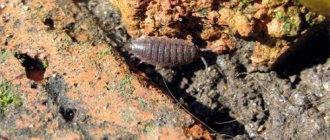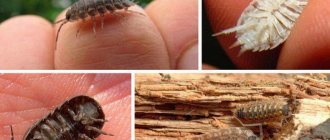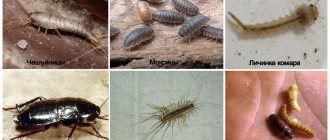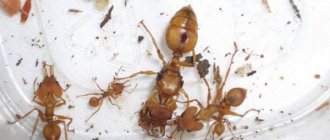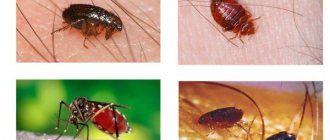Silverfish are insects from the bristletail order. Their genus includes only three species:
- Lepisma baetica
- Lepisma chlorosoma
- Lepisma saccharina
Lepisma saccharina, also known as the common, sugar, silverfish or simply silverfish, is the only species that is found in Russia; the other two live in the tropics. In nature, silverfish are busy processing organic matter, which they feed on, but sometimes they penetrate into rooms and remain there for a long time. What do they need in your home? Why and where do these insects come from? How to distinguish them from other similar pests and how to get rid of silverfish in an apartment?
Calculator
Calculate the cost of exterminating insects in the house
Number of rooms:
(Cold fog)
(Cold Fog + Barrier Defense)
(Hot fog + Premium drugs + Barrier protection)
(Hot fog + VIP drugs + Barrier protection)
Total cost: 01
Order processing
Sugar silverfish: description
If you think that you have a sugarfish in your apartment, a description of its appearance and habits along with a photo will help you be sure whether it is it.
What does it look like
- Lepisma saccharinum has a round, flattened, elongated body, gradually tapering from head to tail.
- The body length of an adult individual usually reaches 1 centimeter; in particularly favorable conditions, insects can be slightly larger.
- The body is covered with chitinous plates that overlap one another like armor.
- The color of silverfish, depending on the stage of development, can vary from white to dark gray with a metallic tint. The older the silverfish, the darker it is.
- The head is crowned with two long mustaches, often equal in length to the size of the body.
- In the caudal part there are soft cerci directed to the sides and a long caudal filament in the center.
- The insect has three pairs of legs.
How it moves
- Moves in jerks, alternating running with short stops.
- Due to the position of the legs, during movement the insect’s body bends and wags like a fish’s tail.
- Due to its physiological characteristics, silverfish can only run on horizontal and inclined surfaces; they are not capable of reliably clinging to a wall or ceiling with their paws.
- The silverfish quickly runs away if the light is suddenly turned on in the room where it is located.
How it lives and reproduces
- Silverfish larvae look exactly the same as adults, but are smaller in size - on average 0.5 millimeters or more, depending on the stage of development.
- The larvae are always lighter than adults; they can be white, pearl-colored, or silver.
- Over the course of her entire life, each female silverfish lays about 100 eggs.
- At temperatures around 22° C, the larvae hatch from the eggs after about 40 days, at temperatures close to 32° C - after 20 days.
- The sugar silverfish larva develops to adulthood in approximately 1 year.
- If the silverfish does not die for reasons beyond its control, it can live up to 8 years.
- At temperatures of +5° C and below, Lepisma saccharinum can go into suspended animation and survive in this state without food for 9–12 months.
- Silverfish can molt up to 60–70 times in their lifetime, including as adults up to the age of 4 years.
Silverfish are sometimes confused with woodlice and two-tailed fish. Woodlice are rounder and have 7 pairs of legs, not 3, double-tailed ones are darker and larger, their cerci in the tail are harder, the insect can use them as a weapon, lifting them up and spreading them to the sides. Silverfish are not aggressive and always prefer to hide from any threat, exposure to sunlight and electric light.
Appearance of silverfish
To notice such a small and inconspicuous insect, you should familiarize yourself with its external characteristics. Adults reach a body length of up to 1.9 cm (without antennae). Because they grow throughout their lives, the size of most silverfish ranges from 0.8 to 1.2 cm.
The body of the pest is quite flat, the head barely stands out against the background of the rest of the body. The chest is wide. The body gradually tapers towards the tail, and also has a subtle division into segments. It is covered with scales that change color during the molting process.
The most common type of silverfish is the common silverfish or sugar silverfish.
Among the shades are:
- dark brown (up to almost black);
- pale brown or dirty yellow (more common in young insects);
- light yellow or white (relatively rare color);
- silver (the body of such a representative has a bright, cold tint).
The silverfish has long, thick antennae that point forward and diverge slightly to the sides. In addition, a distinctive feature of this insect is the three threads at the end of the tail. These threads are extremely similar to antennae. The silverfish has three pairs of short but thick legs. The eyes of the pest are complex, faceted.
Causes of silverfish in the apartment
Silverfish can get into an apartment:
- Do it yourself, using ventilation shafts, grooves and cracks in communication wiring, cracks around windows and thresholds.
- Accidentally end up in packaging, bags or purchased goods.
- Cling to clothes, shoes, or get into your bag if you are in the place where they live for a long time.
- Arrive on pet fur after a walk or trip to the country.
- Live on houseplants and get into the house with a new potted flower.
If silverfish crawl on their own, then, as a rule, they live either in the nearest basement, or with neighbors, or on the street. In nature, Lepisma saccharinum lives under fallen leaves, stones, and in cracks in stone and cement masonry. In search of food in the summer, insects may well crawl into rooms, especially on the first few floors of a building.
The reasons for the occurrence of silverfish in an apartment cannot always be determined for certain, but this is not critically necessary information for pest control. What is much more important is why insects remain once they get into the apartment. For a comfortable life, they need a special environment and combination of conditions. For silverfish it is:
- Warm, optimally in the range of 22–27° C.
- High humidity – from 75% and above.
- Darkness.
- Secluded places, areas, crevices where you can hide.
- Water and suitable food.
The diet of silverfish includes foods rich in carbohydrates, in particular polysaccharides. In residential areas, silverfish can eat:
- Millet, oats, rye, barley
- Lentils, mung beans, peas, chickpeas
- Hair, exfoliated skin particles, dandruff
- Sugar and products containing it
- Paper, photographs, plaster
- Fibers of fabrics, clothing, interior items
- Remains of dead insects
- Chitinous coverings shed during molting
- Microorganisms growing in moist environments
- Decaying green houseplants
In search of food, silverfish are able to travel distances that are quite large for their body size, although they still try to somehow optimize their movements and, if possible, reduce their distance. Most often, silverfish can be found in an apartment in the bathroom, shower, toilet or kitchen. They can also be in rooms, but somewhere nearby there must be a dark, warm and secluded place with a high level of humidity. A crack next to a leaking battery or a flower pot with constantly waterlogged soil on the windowsill would be perfect for its role.
What do insects look like and why do they start living in our apartments?
The silverfish is a wingless insect belonging to the Bristletail family. She is particularly nimble. The pest is active at night; when the lights are turned on, it tries to hide as quickly as possible.
Silverfish
The body is oblong, length ranges from 0.8 mm to 1.9 cm, depending on the stage of development. Color varies depending on the variety.
Silver silverfish, also called sugar silverfish, often live in apartments.
The width of the body near the head of the insect is wider than at the base of the tail. There are long whiskers on the body: 2 on the head and 3 on the end of the body. There are many legs along the body, which allows the pest to move quickly.
Insects prefer to settle in warm places with high air humidity.
You can meet them in the kitchen, bathroom, basement, library. They feed not only on food, but also on paper, book bindings, mold, wallpaper paste, old photographs, etc. They spoil food and things, leaving their excrement and scales everywhere.
A large number of such uninvited guests can lead the family archive to paper trash. You can notice traces of their presence by the characteristic perforations on the paper: when they eat it, they leave holes.
It is recommended to respond to the appearance of uninvited guests immediately, without expecting mass spread
Where do silverfish come from in the house, how do they get into the apartment:
- from a travel bag (after visiting a hotel or other public place);
- with newly acquired items that were stored in a warehouse with high humidity;
- with books from the library;
- through ventilation shafts;
- with vegetables stored in the basement;
- through cracks in the wall;
- with building materials;
- through cracks in the floor.
Are silverfish dangerous for humans?
Silverfish:
- Don't bite
- Don't drink blood
- Are not carriers of diseases
However, like any other insects, silverfish live in contaminated places - sewers, ventilation, soil and come into contact with decaying organic matter. Their bodies, shed chitinous coverings, and excrement may contain harmful bacteria that can cause a local allergic reaction on the skin upon contact and lead to gastrointestinal problems if you eat foods that the silverfish have eaten.
Whether silverfish are dangerous to humans, things and objects in the house largely depends on their numbers. The more insects, the more often they come into view and the more abundant the amount of dirt from them. In addition, a large number of pests require more food, and damage to fabrics, clothes and objects can become noticeable. In order not to bring the situation to a critical scale, you need to start destroying pests as soon as you notice them. The sooner you start doing this, the easier and faster you will be able to get rid of insects.
Why is silverfish dangerous? What harm does it cause?
Silverfish, contrary to popular belief, do not pose a threat to humans. It does not carry diseases and does not bite or sting. Thus, the insect does not pose a serious danger.
With a small number of individuals, silverfish practically do not spoil things, that is, they do not interfere with the owner of the house in any way.
But still, this insect is considered to be a pest. This is justified by the following facts:
- The silverfish population is rapidly increasing, so the damage is becoming more noticeable. These insects chew through packages and damage books, linen and curtains. They can also further worsen the condition of old wallpaper or rotten wood.
- Laying eggs and remaining adults in human food. Although silverfish are not carriers of diseases, they can reduce the quality of food to the point where it becomes completely inedible. In addition, the pest, constantly moving, collects dirt and dangerous microorganisms on its own body. It can be dangerous if it gets into human food.
- The appearance, abundance and rapid movement of silverfish irritate people. The insect sometimes gets into the bed, inside the refrigerator, into the sugar bowl or other places. This makes people very nervous, disgusts them, ruins their sleep and reduces their performance.
This pest, despite being picky about living conditions, is highly resilient. Destroying a population that has settled somewhere is quite problematic. This is another reason why the insect is classified as a pest. This survival of silverfish is justified by the fact that it is most likely the ancestor of modern insects. Judging by the remains found, the pest has existed for about 400 million years. This fact is the main indicator of the survivability of this insect.
It is believed that silverfish are most dangerous for museums and libraries. In these places there is a lot of food, which is valuable for the insect, as well as various cracks and dark corners. For this reason, both museums and libraries follow strict rules regarding indoor humidity levels.
Silverfish: how to get rid of an apartment - effective ways
To get rid of silverfish completely and permanently, it is necessary to combine preventive measures with extermination measures. In general, your pest control plan should look like this:
- Determine where pests accumulate and live by observing them and inspecting areas with a suitable environment.
- Change the microclimate in the apartment so that it becomes unsuitable for pests - first of all, reduce the humidity level.
- Carry out massive baiting of silverfish using selected means and methods.
- Isolate the house as much as possible from the penetration of insects by eliminating minor damage in the apartment and cosmetic or major repairs.
The last step is relevant in the prevention and control of any type of pests, therefore, by using the recommendations from this category, you will protect your home not only from silverfish, but also from much more harmful and dangerous insects that can encroach on it. What exactly is silverfish afraid of, how to get rid of it in an apartment, and what effective methods exist for this?
Means and methods to get rid of silverfish
To combat the pest you need to use different means. When carrying out disinfection, the poisonous liquid must be alternated, since pests get used to its action.
It is preferable to use folk remedies when the number of pests is small, and chemical preparations are recommended to be used when there is a massive accumulation of insects.
With the help of alum
To prepare the solution you will need to boil 100 ml of water. Dissolve 100 g of alum in the resulting liquid. Stir the resulting mixture until smooth.
Pour the liquid into a spray bottle and use to disinfect the room. For complete destruction, treatment should be repeated at least 2-3 times.
Using boric acid
Another fairly effective remedy for quickly getting rid of annoying silverfish is boric acid.
Preparation of the product:
- Combine boric acid with chalk in a ratio of 1:4.
- Mix the ingredients until smooth.
Sprinkle the resulting powder generously in all corners and in places where pests are concentrated. After a week, remove the mixture along with the remains of insects.
Then re-pour the powder into all corners of the room, not forgetting the most secluded places. This will help destroy the hatched larvae from the oviposition. After 7 days, completely collect the product and carry out general cleaning using chlorine-based cleaning liquids.
Baking soda, red pepper, tobacco
Spices are effective against silverfish.
To prepare this solution you will need to take 3 g of each component. Pour the mixture into 1 liter of warm water. Stir the solution and leave to infuse for 30 minutes. After the time has passed, strain the liquid and pour it into the sprayer.
Spray an even layer of the solution into suspected pest habitats. Leave for 8 hours. Afterwards, do a wet cleaning and dry the room.
Spices
You can cope with a small accumulation of pests with the help of spices. An effective combination is a mixture of cinnamon and cloves.
The mixture should be sprinkled in all corners, in the bathtub, in cabinets and on shelves. This will help repel insects and force them to leave the room.
On a note! Bay leaves, sage and garlic have a similar effect.
Cedar shavings
The smell of fresh cedar wood has a depressing effect on the pest. By scattering shavings, you can force him to leave his home.
The wood should be changed regularly as it dries, so that the smell is constantly present in the apartment for 2 weeks.
Regulation of humidity, heat and microclimate
Reducing humidity and adjusting temperature is necessary no matter what method of pest control you choose. A special device for measuring humidity levels will help you track accurate indicators - a hygrometer or thermohygrometer, which, along with humidity, also shows temperature. You can reduce humidity by:
- Air dryer installations
- heater
- Heated towel rail
- Frequent ventilation
The level of humidity in the bathroom is greatly influenced by the state of ventilation, so if there is excess condensation, it is necessary to clean it first.
Rating of the best remedies for silverfish based on reviews from Internet users
Often, various chemical insecticide solutions are used to quickly eliminate insects. Their effectiveness is confirmed by numerous positive reviews found on the Internet.
"Karbofos"
This poisonous component is designed to quickly destroy a large number of insects that can appear in a person’s home. It has a long shelf life, can be combined with many other types of insecticides, and is affordable.
Karbofos
"Karbofos" has a pungent odor and is not recommended for use in rooms where children and pets are present.
With regular use, insects develop tolerance to its action; you need to alternate it with other components. Aerosol "Karbofos" should be sprayed evenly on the surface and left for 2 days. After time, wash everything off using a cleaning liquid containing chlorine.
"Raptor"
This drug is also effective in combating silverfish. The gel should be spread along cracks, crevices and ventilation hatches.
Treat pieces of cardboard with the product and place them on the floor and in secluded places. After 7 days, repeat the treatment. Do not use the product in rooms where small children and pets are present.
Liquid pyrethrin
Liquid pyrethrin
m
This solution is also effective for killing silverfish in residential areas. To do this, spray the liquid in places of mass accumulation and near cracks and crevices in the floor.
To consolidate the effect, it is recommended to repeat disinfection after 7 days. The use of liquid pyrethrin in areas where children and pets are present is also prohibited.
How to poison with mothballs
You can also get rid of the pest using naphthalene . To do this, you need to place the sachets with the product in the suspected habitats.
However, naphthalene has a specific odor, which not only eats into clothes and upholstered furniture, but is also toxic to humans.
"Diatonite"
Diatomaceous earth is a dry mixture of the shells of single-celled organisms combined with siliceous diatoms.
One of the most common means of removing insects is diatomaceous earth.
This is a substance whose structure consists of many small and sharp particles. Silverfish, running through this mixture, die, because the grains dig into their body. The product significantly reduces their numbers.
It is recommended to sprinkle “Diatonite” generously on the floor in an even layer and leave overnight. The procedure should be carried out wearing a mask so that when spraying particles do not enter the respiratory system.
In the morning, sweep away the powder or vacuum it along with the remains of insects. The substance is safe for humans and pets; it does not emit any toxic fumes.
Folk, improvised, natural remedies
Cedar oil
Cedar oil repels but does not kill silverfish. You can soak cotton pads in oil and place them in places where you often see insects, or prepare a mixture of 500 milliliters of water and 10-15 drops of oil, which you then spray on surfaces.
Helpful advice
Silverfish do not like the smell of any coniferous plants, so to repel them, you can use bags of fresh spruce and pine needles, as well as sawdust for rodents and wood fillers for cat litter made from coniferous wood.
Place pine needles, sawdust or pellets in areas where you often see pests. Sawdust and granules need to be changed once a week; bags of pine needles can be left for a year. Cinnamon
The smell of cinnamon repels silverfish. A suitable source is cinnamon sticks, powder or oil, which is mixed with water in a spray bottle and applied to surfaces where silverfish run.
Citrus
Oranges, lemons and other citrus fruits help repel silverfish, especially when fresh when the smell is most intense. You can use both skins and pulp. Once a week, replace dried cuttings with fresh ones so that the intensity of the smell does not decrease. You can make a surface treatment spray from lemon juice and water.
Carefully!
Lemon juice can lighten fabrics and surfaces.
Before applying it to any material, test the solution on an inconspicuous area or, if in doubt, choose an alternative method. Cucumber skins
Cucumber peels affect silverfish in a similar way to citrus and are used in the same way.
Bay leaves
Dried bay leaves help repel pests. They are especially convenient to use in kitchen cabinets.
Carnation
When fighting silverfish, cloves as a spice are suitable. The inflorescences must be placed in places where insects are found in the apartment. Cloves can also be used in the form of oil, soaking cotton pads in it or preparing a spray with it, however, the smell of cloves is very concentrated. Before you apply it to anything in your home, make sure you like it. It will be difficult to remove it from surfaces and objects.
Why use silverfish repellents?
Repellents are essentially absolutely useless in the fight against most types of pests, but in the case of silverfish, it makes sense to use them.
With their help, you can scare away pests from products and objects that they can spoil. To do this, you need to lay out and apply all repellents close to the places and things that you want to protect from insects. For example, in cupboards with cereals, in a drawer with dirty things in the bathroom, in closets with clothes, etc. Salt
The integument of the silverfish's body is quite thin, so any contact with salt can cause harm to the insect, even death. You can sprinkle salt directly on insects, or in places where you often see them. Leave the salt for a week, then vacuum it up. Repeat the procedure several times, tracking changes.
Diatomite
Diatomaceous earth, diatomaceous earth or diatomaceous earth acts on insects in the same way as salt, but works faster and more intensely. Diatomaceous earth must be scattered in areas where silverfish live. When contacting it, pests will die from dehydration.
note
Diatomite works only in a dry state.
It is advisable to scatter the powder in places where there is no strong draft, otherwise it will scatter throughout the apartment. Boric acid
From boric acid powder and starch-containing products, you can make food baits for silverfish and place them in small portions on substrates in places where the insects live. Mix boric acid powder with food bait in a 1/1 ratio. Suitable attractants with a high starch content are:
- Corn grains
- Rice
- Beans
- Potato
- Bananas
Food and acid must be mixed until smooth before use.
Carefully!
Place food baits only where pets and small children cannot reach them, or choose alternative baiting methods.
Baits with boric acid, if they enter the gastrointestinal tract, are equally dangerous for people, animals, and insects. Household cleaning products
Any household cleaning products, especially those based on chlorine, can destroy the integument of silverfish. Use them regularly to clean the bathroom, bathroom fixtures, and tiles.
Recommendations for disinfection in the apartment
It is recommended to react to the appearance of uninvited guests immediately, without expecting mass spread. Both chemicals and folk remedies are suitable for killing insects in a room/apartment.
You need to start processing after following a number of recommendations:
- It is first recommended to do a wet cleaning of the apartment , thoroughly wash all secluded places using cleaning liquids with the addition of chlorine. Wait until the treated surfaces dry.
- Remove children and pets from the premises and cover the aquariums with film.
- Prepare special clothing , a respirator and rubber gloves for your own safety.
- Pack all products in airtight bags or seal them in jars.
- Move all objects away from their intended habitats, clear out the corners.
- Spray the poisonous agent in all corners and surfaces.
- Close the windows and doors of the room for 1 hour.
- After time has passed, ventilate.
- Do not carry out wet cleaning for 1 week, then disinfect again.
- After waiting a week after re-treatment , wash all surfaces again and place objects in their places.
Insecticides
Insecticides in the form of aerosols, sprays and concentrates are suitable for treating silverfish habitats, for example, such as:
- August Cucaracha Spray
- Concentrate Medilis-Super
- Aerosol Clean House from skin beetles
- Raid Max aerosol
- Combat SuperSpray
Using any glue-based insect traps on substrates is also effective. They will need to be changed periodically as they become dirty.
If silverfish are infested in clothes and bookcases
Cabinet doors should be left open periodically to reduce humidity.
In this case, it is recommended to use homemade traps to help catch insects.
You can use any of the following options:
- Wrap the outside of the glass jar with electrical tape. Place bait in the form of sugar or starch at the bottom. Place the container in a closet, shelf or other place and leave overnight. The pest will smell it and will rise up and fall into the trap, and will not be able to get back out along the internal slippery wall.
- Roll up the newspaper into a loose roll. Place rubber bands on both sides to prevent the paper from unrolling. Lightly moisten it with water. Lay oilcloth on the cabinet shelf and place a folded roll of newspaper on top. Leave the trap overnight. In the morning, take the roll outside and burn it.
To prevent uninvited guests from re-occupying your closet, you should use repellent seasonings:
- cloves;
- sage;
- laurel leaves;
- cinnamon.
Cabinet doors should be left open periodically to reduce humidity . Clothes should always be dried and ironed. Books should also be shaken periodically and dust removed from them.
These simple recommendations will help you get rid of silverfish in your closet, chest of drawers and bookshelves.
Favorite habitats in apartments and private houses
Damp places are a home for insects. If there is mold and mildew in the apartment, you can expect the appearance of parasites. Dark corners of rooms are typical locations for these pests. Silverfish and other insects in the apartment must be destroyed so that they do not breed in large quantities.
The favorite place where insects settle is the bathroom. After a shower, it is recommended to wipe the floor and tiles, ventilating the room. Dripping faucets and pipes are another source of moisture that needs to be eliminated. Silverfish live in ventilation shafts.
Another favorite place for insects is the kitchen, since there is always moisture and food there. Basements, laundry rooms and attics should be under close attention.
Prevention
The best way to get rid of insects is to keep your apartment clean and have the right microclimate.
Cleanliness, humidity not more than 50% and the use of chlorine-containing detergents will help you get rid of insects and prevent their appearance in the house
The best preventive measures are as follows:
- After taking a shower, wipe the walls and floor dry. Leave the bathroom door open to properly ventilate and dry the room;
- if a faucet drips or pipes leak in an apartment, solve the problem in a timely manner;
- do not forget to clean the ventilation ducts;
- get rid of dirty and wet laundry in a timely manner, otherwise it will become a habitat for pests;
- If possible, ventilate your home at least twice a day;
- reduce the humidity level in the apartment. Use a dehumidifier, air conditioner or fan heater;
- seal all the cracks in the house to prevent insects from spreading throughout the apartment;
- Clean your home regularly and thoroughly;
- Disinfect the premises with chlorine-containing detergents from time to time;
- When cleaning, do not neglect the vacuum cleaner - it will collect not only garbage from small cracks, but also a brood of pests;
- Eliminate all food sources for silverfish. Store food in airtight containers and thoroughly wipe kitchen surfaces from spills and food debris;
- store unused clothing in sealed bags or containers;
- Place books and paper items in areas with dry air.
Store aromatic spices in your kitchen cabinets - they will repel insects
Following these simple recommendations will help you get rid of silverfish and prevent the insects from reappearing.
Insect repellent aerosols and gels - a review of the best
Sprays and aerosols are in great demand due to their ease of use and consistently lasting effect. Spray them in a closed room, free from pets and children, with food, children's toys, dishes and other things covered with protective film.
Most often used:
If silverfish appear in the house, how to get rid of it with the help of Dichlorvos? This is not difficult to do, especially since the aerosol has been improved, does not have such a pungent odor as before, and has a positive result if used correctly. The aerosol is used with protective gloves and a respirator, and is sprayed near possible insect habitats, including corners and tile seams.
The leader among gels is “Raid”. The product is applied around the perimeter of the room where insects were noticed, increasing its amount in hard-to-reach places. The result will make itself felt only after a few weeks, but compared to the same Dichlorvos, the gel is less toxic.
CB-80 Contact Aerosol, a concentrated pyrethrin, is considered no less effective. It is used against midges and cockroaches; you can also try to fight silverfish with it, although there are no reviews of the results of the fight yet. The peculiarity of the drug is its specific smell.
Reasons and ways of penetration of silverfish
A prerequisite for the existence of insects is humidity. That's why creatures sneak into our apartments. There are many ways through which parasites enter a home.
Silverfish enter houses through ventilation shafts. Cracks, crevices and open windows are sources of danger. The small size of insects allows them to penetrate through holes in walls.
Objects and products contaminated with larvae or adults are no less dangerous. Silverfish can be found in books, boxes, and products. The modest size of insects does not allow them to be detected immediately, since they are nocturnal. You can only see them if you suddenly go into the kitchen or bathroom at night and turn on the light.
Insects choose those apartments and houses in which the microclimate is clearly disturbed. High levels of humidity, condensation, cracks and debris in the house are an ideal habitat for parasites. Silverfish prefer damp and warm rooms. It is not difficult for them to get into any house. If the conditions turn out to be comfortable, the pests will settle in a new place.
Habitats
These insects love dark and damp places. All rooms with high humidity and no ventilation are at risk. Ideal conditions for silverfish are humidity from 75% and temperature +21…27 ℃. In addition, these insects accumulate in large numbers where their favorite food is: paper, rags, bulk products or construction waste. Typical habitats:
- bathroom and toilet . Humidity and warmth are the most suitable conditions for most insects;
- utility rooms (laundry room, boiler room, pantry, etc.). And also all places where insects can find wet or old linen, wet rags;
- kitchen . Sugar silverfish will always find a treat in the kitchen: sugar, crumbs, cereals and starch;
- basement and cellar . If you don't clean basements and attics regularly, they will become a haven for insects;
- baseboards and window sills . Cracks in old wooden windows and baseboards are favorite habitats for white silverfish;
- book and linen closets . These insects are practically omnivorous and can find food everywhere. Their intestines contain enzymes that digest paper and turn it into nutrients. They will not disdain your home library, archives, stacks of old documents and newspapers. In linen closets they will feast on items made of silk, cotton, linen or viscose.
Insects often enter an apartment along with building finishing materials, old books and magazines. Given their ability to travel long distances and go months without food, you can bet they'll get inside your home at the first opportunity.
If there are a lot of pests, don’t expect them to voluntarily leave the premises - declare a fight against them. Let's take a closer look at how you can get rid of silverfish on your own.
Reasons for the appearance of silverfish
High humidity is the only cause of pest invasion. They enter the room from:
- ventilation pipe - this is how most of all insects get in;
- cracks, cracks, windows and doors that are not tightly closed - the miniature size facilitates unnoticeable penetration;
- foreign objects - food, boxes from the basement, books, fabrics.
Silverfish in the house.
What is silverfish?
The insect is a small wingless creature with bluish silver skin. It can be mistaken for a small fish, but fish do not crawl. She has two long tails on her head and three more different tails in the back, and is a nasty creature.
Small nimble insects live in dark places and come out only at night; they are not friends with any animals or people. They cannot harm a person, they only cause unpleasant emotions. Woodlice cause significant damage to wallpaper, clothing and valuable books. They feed on paper and love glue. They reproduce very quickly and live up to three years. One female lays from 2 to 20 eggs daily, from which young insects hatch after 25 days. After three months they become adults and lay eggs again. To remove silverfish using effective home methods, you need to be patient - they take a long time. Before starting the fight against silverfish, drain all wet places in the house, and if necessary, install a sewer system. To fight you will need:
- Boric acid.
- Red pepper, soda, tobacco.
- Alum.
- Insecticides.
Silverfish looks like a small fish
How to catch silverfish: the best traps
Lure Delicia silverfish and cockroaches
This is a very profitable offer. For 1300 rub. you get a huge box of 90 mini traps. They are made of simple material: we have light cardboard with an adhesive surface inside. There is no poison or bait there. But this simplicity, coupled with efficiency and versatility, is what gives the traps a high rating.
All boxes are formed into blocks of three cells: you can lay them out around the house in this form, or you can divide them into very small traps. The first format is suitable for cockroaches, and the second is just fine for silverfish.
Conveniently, Trapper Insect Traps has a special space for recording the time and date of installation of the cardboards. This will make it easier to track the results of the “hunt” and remember to replace the traps in time after the adhesive tape has dried. With a light strip of glue on the bottom, the triangle can be attached almost anywhere.
When placed correctly, Trapper Insect Traps are effective against our bugs. People write that they can be used to catch silverfish “in bulk”: the more cells you install, the more insects you will catch.
Price: 199 rub.
Summary table of silverfish remedies
| Name | Against who | Price |
| Grand product | Type of insects: silverfish, fleas, bedbugs, mosquitoes, larvae, ants, flies, cockroaches | 1249 rub. |
| Aerofumigator RAPTOR | Type of insects: silverfish, fleas, moths, mosquitoes, ants, wasps and hornets, cockroaches, flies, spiders | 441 rub. |
| Aerosol Insecta | Type of insects: silverfish, fleas, bedbugs, mosquitoes, larvae, moths, ants, flies, crawling insects | 162 rub. |
| Spray RAPTOR | Type of insects: silverfish, fleas, bedbugs, mosquitoes, larvae, moths, ants, flies, crawling insects | 239 rub. |
| Aerosol mukhoyar | Type of insects: silverfish, fleas, bedbugs, mosquitoes, larvae, moths, ants, flies, crawling insects | 120 rub. |
| Delicia bait | Type of insects: woodlice, cockroaches, silverfish | 199 rub. |
Demon Wp – Envelope (4 of 9.5g Packets) -1 Envolopes
This granular substance in 9.5 gram bags acts against a couple of dozen insects: cockroaches, bugs and flies, etc. Demon Wp is also known to be an effective ant killer and silverfish killer.
The active ingredient used here is cypermethrin - a synthetic peritroid, a sibling of the chemicals that experts recommended to us. Sellers write that the dust can be used outside and inside the house, and it is better to shake the bag before use. They honestly don't recommend spraying it near dark furniture as it may leave stains.
Judging by the comments, the product works well against silverfish:
“I have been using this product for years. I sprinkle this on the base of my cottage outside and it dramatically reduces the number of spiders that live there. I tried to use this remedy in my cousin’s house and the problem with silverfish went away.”
We did not find any reviews on thermobium.
Safer Brand 5168 Diatomaceous Earth Powder Ant, Crawling Insect and Bed Bug Killer
This product is based on diatomaceous earth. Safer Brand 5168 Diatomaceous Earth is considered a horticultural product, but the powder can also be used indoors. The substance (in theory) should kill insects within 48 hours by completely dehydrating the body. Dry and porous powder simply absorbs all the moisture around it: it is only necessary for the silverfish to swallow it.
This is a very simple, all-purpose, non-toxic treatment suitable for cockroaches, ants, crickets, centipedes and earwigs. It seems like it can even be used in beds, mattresses, kitchens and living rooms... But is SB capable of killing silverfish?
Data on the effect of Safer Brand DE on silverfish and thermobiae vary. Some clients report significant population declines. Others complain about the low effectiveness of the powder. Negative and positive are approximately equal. It is clear that the dust still attracts bugs, but perhaps it does not look too appetizing to them...
We still recommend this product to readers. Moreover, the substance poses almost no threat to the person himself. Of course, it needs to be hidden from children and is unlikely to be sprinkled on food, but there is no poison there. Only a couple of people in the comments complained of slight skin irritation after constant contact with the product. However, it is difficult to imagine what they did with the dust: did they rub themselves with it or something?
Dekko Silverfish Paks DEK1002 (Pack of 2)
And this thing is something between poison and a trap. The box contains 24 cellulose bags impregnated with boric acid. They need to be placed in places of possible infestation and wait for the insects to start eating their favorite piece of paper. And as soon as they eat it, they die.
The instructions say that you should place 2-3 sachets at each source of infection. And basements and attics can simply be filled with them. Significant changes in the parasite population should appear within 3 days to 4 weeks from the moment the product is unpacked.
The main advantage of Dekko Silverfish Paks is that it was developed specifically for the “anti-heroes” of our review. This is noticeable even in people’s reaction to the product. In the comments, they share their thoughts on where it is better to place the treasured bags. They are laid out in toilets, showers, and ventilation shafts. But it’s better not to put pieces of paper next to food: it’s poison after all. This is also dangerous for pets, although they are not very interested in cellulose.
Above, we cited the opinions of scientists about the relative ineffectiveness of boric acid against silverfish, but perhaps this is the case when the opinions of real users will be much more significant - 77% of buyers positively assessed the product from Dekko. A good, although not very universal remedy.
Boric Acid Roach & Ant Killer NET WT. 1 LB. (454 gms)
This is a classic dry boric acid powder, which is cheaper than the previous product and is easier to pour into cracks and holes. This product costs approx. 380 rubles, and it sells almost better than all the participants in our rating. However, you can’t call it special: Boric Acid Roach & Ant Killer is simply popular for getting rid of ants and cockroaches, which is why it has a good rating. But this substance is also capable of dealing with silverfish.
Insect repellent powders are quite effective, but cannot boast of fast action. For those who cannot and do not want to wait for the heroes of our article to leave their house alone - the next point.
Let's summarize:
If silverfish have appeared in your home, there is no need to panic. Experts have long developed an algorithm to combat them. First, calculate the location of the enemy, then put things in order in your house, and as a last resort, take on sprays, dusts and traps (fortunately, there is a choice on the market). The main thing is not to forget about preventive measures against these nasty insects. And then they won't bother you anymore.
Concentrated insecticide - which one to use?
If you can’t get rid of silverfish at home using aerosols or gels described above, you should try the concentrated insecticide Cyzmic CS, 230 grams of which will yield 150 liters of a ready-to-use solution. Use the product with extreme caution, following the instructions, using protective clothing.
The drug was developed and packaged in the USA and, according to the manufacturers, can effectively work against silverfish and several dozen other pests, including garden ones.
In addition, exterminators advise choosing a silverfish remedy from the list below:
Diatomite is domestically produced, available in the form of 1 kilogram powder. It contains natural organic matter - phytoplankton. The drug is sprayed in the habitats of silverfish every 5-6 days to prevent reproduction.
Diatomite
Pyrethrin is also produced in Russia and is sold in liquid and powder form. The basis is a natural plant substance - varieties of chamomile. The drug acts on a number of insects, including crawling and flying ones, and can cause an allergic reaction. Available in natural and synthetic forms. The first option is preferable.
Cyfluthrin acts on crawling and flying insects and has a prolonged effect. Signs of poisoning are observed within 10 minutes after the room has been treated. Repeated treatment after 10 days may be necessary if the room is heavily populated with silverfish.

